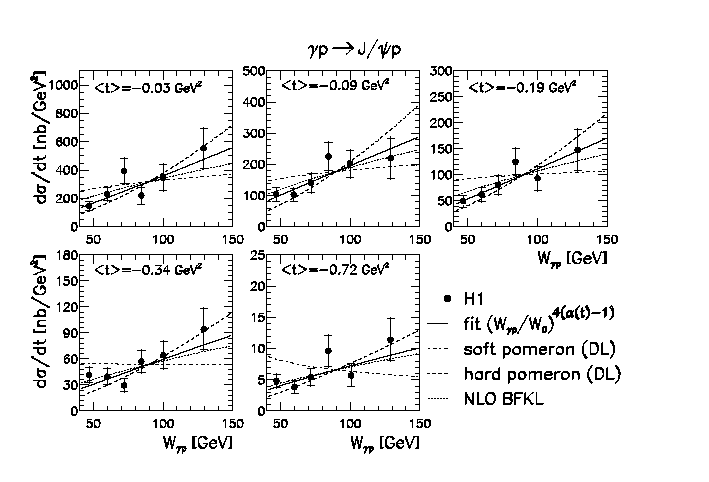Elastic Photoproduction of J/Psi and Upsilon Mesons at HERA
|
The H1 experiment at the HERA ep collider has measured
the differential photoproduction cross sections gamma p--> J/Psi p in positron
proton collisions for an extended range of gamma p center of mass energies
W.
This follows earlier measurements of the total photoproduction cross section
(Nucl.Phys. B472 (1996) 3 ). The J/Psi, a bound charm-anticharm
state, which carries the same quantum numbers as the photon, is produced
in the chromodynamic field of the proton, which recoils intact.
The peripheral nature of production, namely with small momentum transfer
(-t) to/from the proton, is characteristic of a diffractive
mechanism. The purely charm-anticharm content of the J/Psi ensures that
neither of the quark structures of the proton (uud) and of the J/Psi (ccbar)
can be exchanged in the production mechanism, so that it is purely diffractive.
Hence, the t-channel process is dominated only by an exchange carrying
the vacuum quantum numbers, generically termed pomeron exchange,
and there can be no additional contributions from meson exchange, which
are characteristic for hadron-hadron collisions.
The charmonium nature of the J/Psi also provides an inherent hard scale
in the form of the charm quark mass squared mc2.
Thus the process is the cleanest way of studying hard diffraction,
and as such it provides a unique window on its interpretation in the framework
of perturbative Quantum Chromodynamics (pQCD)..
The measurements (see figure) show the W dependences at different
t
of the differential cross section dsig/dt in the peripheral production.
The cross sections are observed to rise steeply with increasing W even
out to large, less peripheral, values of -t. This rise is everywhere
greater than that observed in soft diffractive vector meson photoproduction,
such as in gamma p --> phi p. Such an observation has been anticipated
to a lesser or greater extent in theoretical calculations based on perturbative
QCD. The quantitative outcome of these measurements now becomes a challenge
to these attempts in QCD to understand diffraction and a QCD based procedure
of calculating the way hadrons interact, as is clear from the comparison
of different calculations with the results (compare NLO BFKL).

It would be interesting to investigate the same behaviour for the even
heavier Upsilon vector meson, a bound state of beauty and anti-beauty quarks.
Being 10 times as heavy as the proton the mass should provide the natural
scale for pQCD calculations and lead to results with even less theoretical
ambiguity. Because of its large mass the production cross section in gamma
p interactions is severely suppressed and the data are not yet of sufficient
statistical accuracy to disentangle the t-dependence. The H1 collaboration
has however managed to present a measurement of the total cross section
for Upsilon production, which is found to agree with the models based on
pQCD within the large uncertainties.
Last Update Mar 3, 2000, E. Elsen
